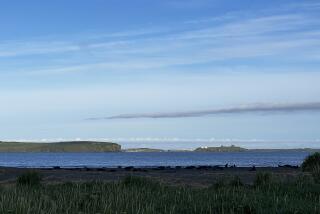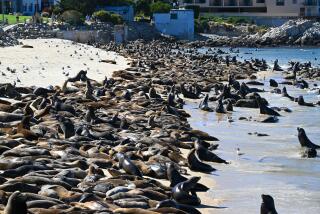Taking the Channel Islands Back to Nature
SANTA CRUZ ISLAND — Naturalist John Muir called sheep “hooved locusts,” and standing on the rocky spine of the El Montanon ridge it’s easy to see why.
On one side of a rusted wire fence, where sheep herds were allowed to freely roam, the slopes are so denuded by grazing that they look as if they were shaved by a giant razor. Sloughed sandstone spills into gorges that bleed milky silt into the green sea and kelp forests.
On the side of the fence protected from sheep since 1985 flourishes a vibrant mosaic of coastal sage scrub, chaparral and dense clumps of oak woodlands.
This scene of devastation and renewal testifies both to the severity of the damage caused by nonnative plants and animals introduced by humans to the islands, and to the ability of the land to recover after the threat is removed.
After decades of damage, the last of the great sheep herds that roamed Southern California’s islands were removed this year. The last animal, an old, toothless ewe hiding in a cave near Mt. High on Santa Cruz, was captured Sept. 8, culminating two years of roundups that netted 9,267 animals and cost $2 million, said officials at Channel Islands National Park.
It marks a major milestone on the path to restoring native flora and fauna to the landscape that greeted Juan Rodriguez Cabrillo when he discovered the Channel Islands in the 16th century.
“For the first time in about 150 years, we have cleared all the islands of sheep, and that is the first major step you have to take before you can move forward to restore the islands to a natural condition,” said Gary E. Davis, senior scientist at the park.
Moreover, it signals a new future for the islands. Whereas vineyards, livestock ranches and orchards once sustained most of the eight offshore isles, today they are largely given over to campers and kayakers, tour boats and fishermen.
“We used to value the islands for commodity production and now we’re in a new era of restoration and environmental protection of natural plants and removal of animals that are out there causing lots of destruction,” said Kate Faulkner, chief of natural resources for the park.
But more work remains to be done to restore the islands. With sheep gone, feral pigs will multiply rapidly and wreak more havoc on Santa Cruz, just off the Ventura County coast. The National Park Service, which manages the five northernmost islands, and the Nature Conservancy are contemplating an all-out assault, including use of rifle squads, herbicide-dropping aircraft and fire, to annihilate pigs and their protective thickets of fennel, a nonnative plant that forms dense, eight-foot-tall groves on the island.
“This is the last big roundup,” park Supt. Tim Setnicka said.
But even though the end is in sight, controversy dogs restoration plans as animal activists question the benefits and morality of killing one species to preserve another.
To the casual visitor, a trip to the islands some 25 miles offshore and worlds removed from the buzz of big cities is like being transported back a century in time to the California that once was. There are few visitors, fewer roads and just a handful of buildings. Upon closer inspection, it is an environment shattered by human-induced change that began in the early 19th century when ranches flourished.
Overgrazing, particularly by sheep, devastated the islands. At their population peak in 1890, about 100,000 sheep roamed over 96-square-mile Santa Cruz Island. Like woolly lawn mowers, sheep cleared virtually all native shrubbery and exposed soil. In some places, Davis said, six feet of topsoil has been blown out to sea or washed down ravines. With so much vegetation stripped away, Santa Cruz Island receives about half as much precipitation as it once did because there aren’t enough plants to capture mist and fog, Davis said.
“You walk around that country and there’s not a blade of grass left on that land. They ate everything,” said wrangler Ralph Lauston, who rounded up the sheep, as he tilted his cowboy hat toward the cliffs where the last herd was removed.
The same thing happened on a smaller scale on other islands. So many sheep grazed on tiny San Miguel Island that it became a virtual desert by the 1930s.
“Islands have unique plants and animals that are not accustomed to grazing animals. Some plants have lost thorns and chemical defenses, making them more vulnerable to grazing. There are no predators and the islands have rudimentary food chains, which makes them more vulnerable to disruption,” said Peter Schuyler, director of ecological restoration for the Santa Catalina Island Conservancy.
Other nonnative species exact a toll. Deer and elk, imported from the mainland for sport hunting on Santa Rosa Island, are thrashing chaparral and are scheduled to be removed by 2012.
Bald eagles once inhabited the islands, but they died out because of DDT and were supplanted by nonnative golden eagles, which were lured from the mainland by an abundant supply of pigs. But the eagles also acquired a taste for island foxes, the largest natural land predator and a protected species on the Channel Islands, and are hunting them to extinction. To restore a natural order, scientists are evicting golden eagles, bringing back bald eagles and trying to salvage the few remaining foxes.
The biological cleansing extends to European hares eradicated from Santa Barbara Island, burros driven from San Miguel Island, horses and goats evicted from Santa Cruz Island and wild pigs eradicated from Santa Rosa Island. Rats, which probably reached Anacapa and San Miguel islands as stowaways aboard boats, are targeted for destruction, Faulkner said. Farther south, goats, pigs and feral cats are being removed from Santa Catalina and San Clemente islands.
Legions of alien species have taken advantage of the ecological turmoil. Sage, coreopsis and tree poppies have declined, while star thistles, European grasses and fennel flourish, Davis said.
Fennel, an invader brought to the United States from Southern Europe, has colonized 6% of Santa Cruz Island, crowding out chaparral and coastal sage scrub that sustain native wildlife and affording impenetrable cover for pigs.
Of all the remaining animals on Santa Cruz Island, none are as troublesome as wild pigs. Between 4,000 and 6,000 roam the island, darting across roads cut like tunnels through thick stands of fennel.
With bulbous snouts tilling the ground to a depth of up to two feet, they churn and trample Chumash Indian artifacts, oak seedlings and bracken ferns. As a result, archeological treasures--some of the oldest human settlements in North America are on the northern Channel Islands--have been lost. Century-old oak groves on the island are slowly disappearing because pigs eat acorns like candy, munch seedlings and ravage roots and soil supporting mature trees, Faulkner said.
The National Park Service is contemplating an all-out assault to eradicate pigs and fennel from the island. A similar effort was successful at Santa Rosa Island.
Dispatching pigs will take at least two years and cost several million dollars. The Park Service, working with the Nature Conservancy, will conduct the campaign. A draft removal plan will be completed by May.
The pigs cannot be relocated to the mainland because they carry a type of rabies that threatens other animals, said Kathy Jenks, director of the Ventura County Department of Animal Control.
But restoration efforts at the Channel Islands are often controversial. Many of the animals targeted for removal have advocates on the mainland.
For example, the Santa Barbara-based Foundation for Horses and Other Animals unsuccessfully sued the National Park Service last year to block removal of 16 horses from Santa Cruz Island. Public outcry in June forced the Navy to stop shooting island foxes to save an imperiled songbird at San Clemente Island.
“We understand their desire to return the island to a pristine state before man arrived, but we don’t agree with their methods,” said Stephanie Boyles, wildlife biologist with People for the Ethical Treatment of Animals. “What they’re going to do [with pigs] is pretty cruel and absolutely unnecessary. These animals have been here hundreds of years . . . man abandoned them and they made their way as best they could and now we’re going to kill them in a pretty hideous way because they got so good at surviving.”
But the National Park Service insists it is not its job to run game preserves or farms.
“They are attempting to manage the islands in perpetuity as a natural system. People don’t always recognize that,” said Paul Collins, biologist at the Santa Barbara County Museum of Natural History.
Removing livestock is costly, too. The National Park Service spent about $220 per animal to remove sheep from the eastern portion of Santa Cruz and ship them to their owners on the mainland.
As grazing animals are cleared out, native plants and animals have demonstrated amazing resilience. On San Miguel Island, stripped bare by sheep and burros until the 1940s, knee-high native shrubs cover most of the island. It is a slow and difficult recovery aided by park officials planting seedlings.
“The islands have shown a tremendous capacity for natural recovery,” Faulkner said. “[It] is pretty awesome.”
More to Read
Sign up for Essential California
The most important California stories and recommendations in your inbox every morning.
You may occasionally receive promotional content from the Los Angeles Times.










